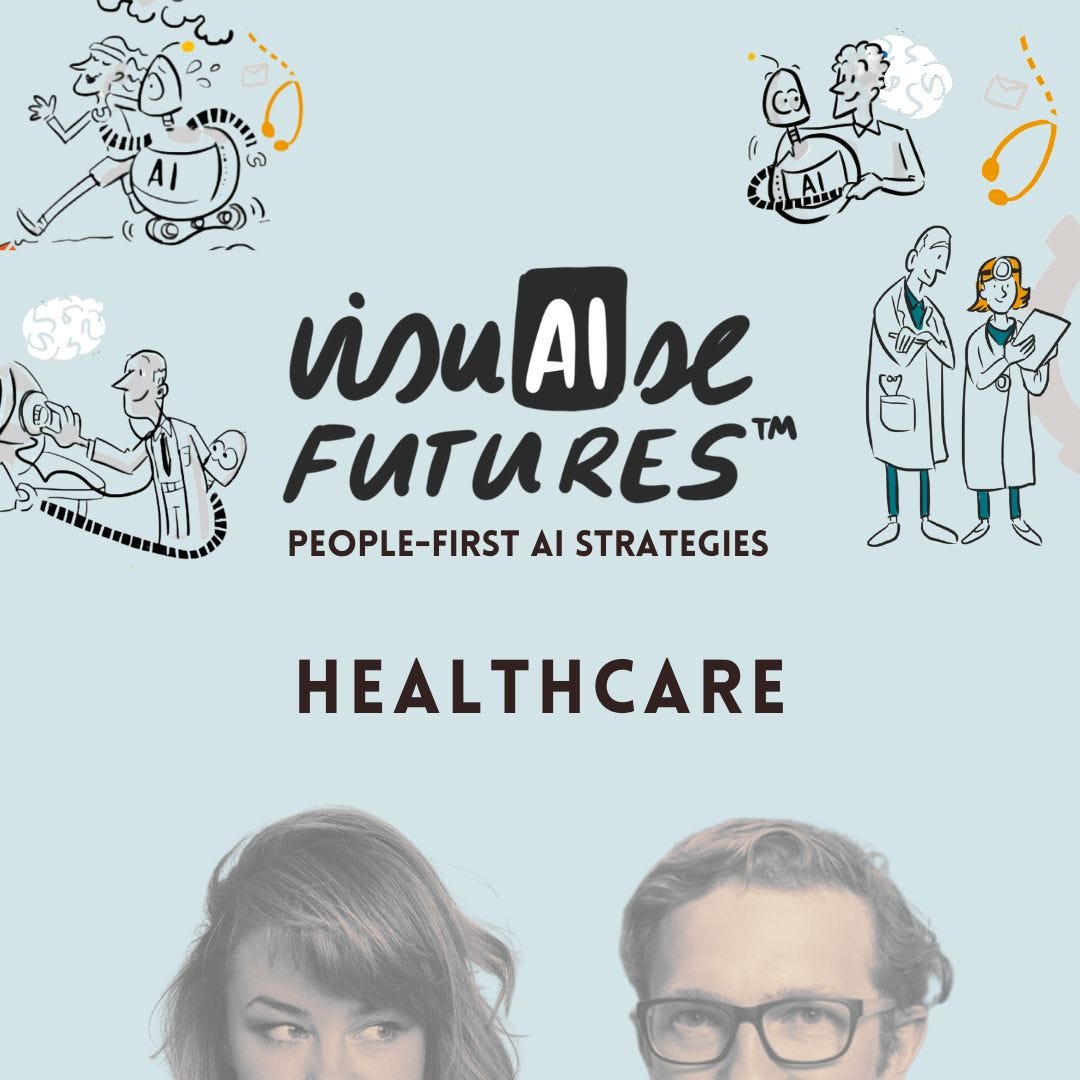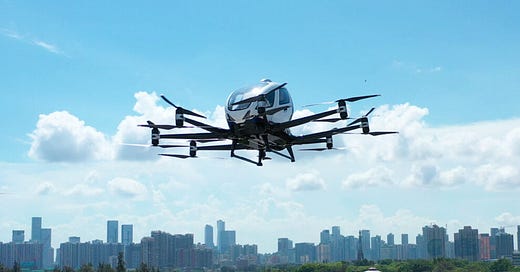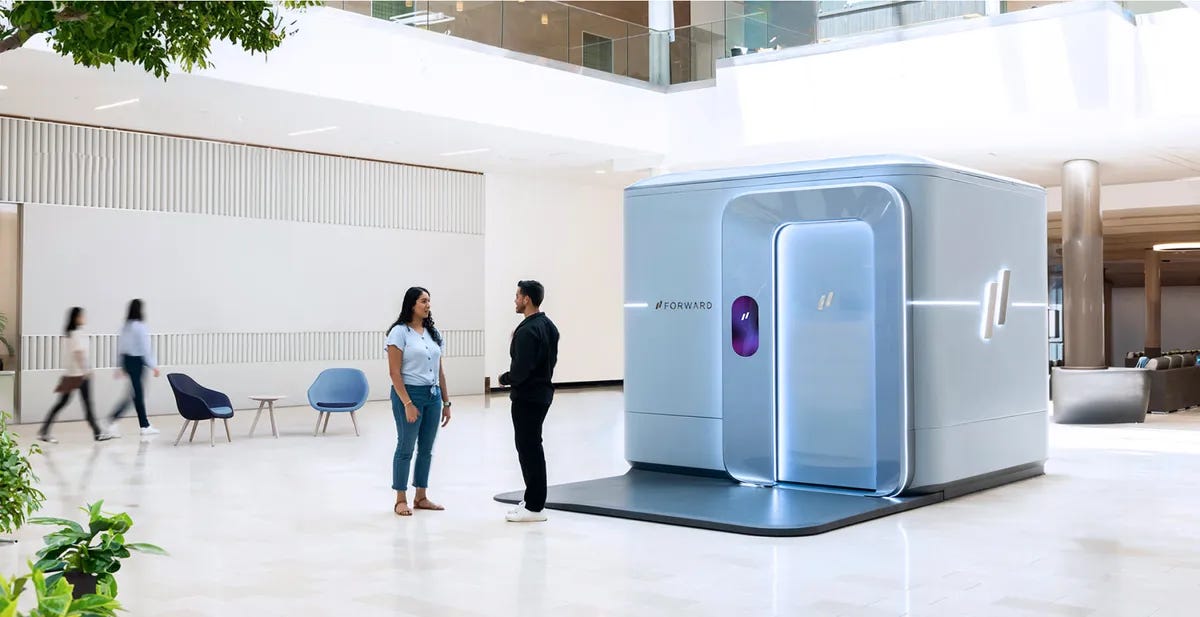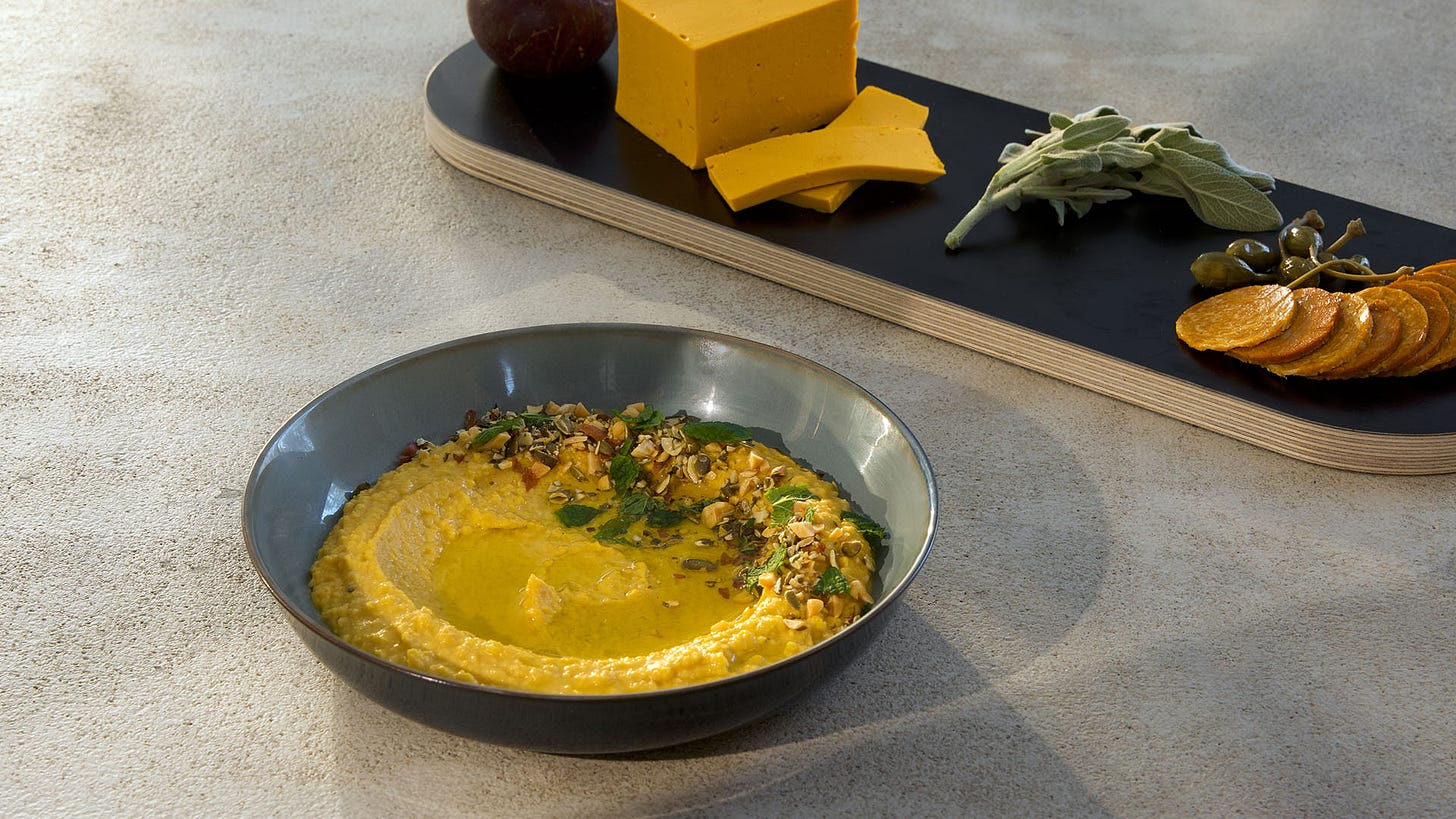Ahhhh the end of the year. It’s that time.
Most readers will have seen the Google Drive link with 92 115 151 190+ trend reports (thanks to Amy, Ci En, Iolanda and Gonzalo). Having spent 13 years writing such reports, I understand the desire to stake a claim on the future. Yet no trend report can escape the fundamental paradox that the future is simultaneously both utterly predictable and yet also completely uncertain.
Predictable: the big macro themes are blindingly obvious. More extreme climate. AI everywhere. Novel tech solutions searching for scale. Increasing economic and social polarisation.
Uncertain: despite this, 2024’s most impactful events won’t be in these reports. It’s easy to talk about potential pandemics and AI; it’s near-impossible to forecast global lockdowns or when AI tools would be adopted by hundreds of millions in a matter of weeks.
Trends are meaningless. Your actions are what matter.
The Big Idea running through this newsletter is that you can use today’s innovations to uncover tomorrow’s opportunities (here’s more on exactly how to do this1).
With that in mind, here are 52 thought-provoking, future-focused questions, inspired by innovations I’ve featured over the past 12 months, spread across:
As I said in last year’s edition, I make no attempt to claim that these are the 'most important' stories from 2023. There are many other lists in that vein. Instead this deliberately eclectic yet hopeful collection should inspire you to (re)imagine what you could do differently – and better! – in 2024.
Dive in, discuss them with your team, and good luck.
Future Normal: Health & Wellbeing
What if… we conquer obesity? It’s not clear whether Ozempic’s hot streak will continue, but it’s an amazing case study in the cross-industry butterfly effects of expectation- (and reality-!) changing innovations.
What jobs-to-be-done will humans play in your organisation? People on combined AI and human coaching plans lost 74% more weight than those on AI-only plans. As Fitt Insider summarises, “accountability is hard to automate.”
What if… ‘seeing’ the doctor was as easy as buying a snack from a vending machine? Forward Health’s AI-powered CarePods will offer automated, AI-powered body scans (side note: Ping An has been making this normal in China for years).
What if… your voice could pre-emptively alert you to future health issues? Cordio’s HearO app uses AI to predict heart failure from patients’ voice signatures, up to 2 weeks out. In the future normal, how will you use AI to measure what matters?
What if… generative AI evolves into regenerative healthcare? AI restored a stroke patient’s ability to speak, by translating into her brain signals.
What if… we tuned into psychedelic wellness? In June, doctors in Australia became the first country in the world to legalise the use of psychedelics to treat some mental health conditions. And the US might follow…
What if… ‘human’ drug trials didn’t need to involve real humans at all? Biotech startup Vivodyne uses robotic automation to create more than 10,000 samples of lab-grown human organ tissue and then tests new drugs on them.
What if… healthcare solutions could be created by those most affected? Fruitpunch’s ‘AI for good’ challenge helped citizens monitor a Dutch steel plant’s toxic emissions. AI will empower patients to hack their own healthcare – will you help them?

Coming soon! Sign up for updates What if … robots could do jobs we can’t? Researchers in Taiwan have developed a robot hand that can detect mercury ions in food simply by touching them.
What if … we could dramatically slow, or even reverse, ageing? A tech entrepreneur has spent $2 million this year and has seemingly reduced certain biological age markers.
What if… daily drug regimes could be replaced by single shots? Verve Therapies’ gene-edited CRISPR treatment slashed patients’ cholesterol after a single infusion. Here’s how this could affect adjacent industries, via my Trend Analyst GPT ;).
Future Normal: Making What We Buy & Consume Better
What if… brands didn’t produce anything new at all? Here’s a fashion brand that produces no clothing, instead using only recycled and dead stock fabrics. Look out for other ‘zero production’ brands, in other industries.
What if… single use products could actually disappear after use? Wild’s shower gel refill is “fully biodegradable in less time than a banana peel.” Soon we will find it wholly abnormal that we used ever-lasting materials for temporary packaging.
What if… electronics didn’t generate e-waste? Pulpatronics makes RFID tags entirely from paper, making them 100% recyclable. We explore Waste-Free Products in The Future Normal.
What if… we embraced synthetic substitutes? Pangaia and Haeckels launched a palm oil-free body soap bar. Lab-grown via fermentation in just 7 days, C16’s synthetic palm oil substitute is most definitely Unnaturally Better than its toxic alternative.
What if… brands shared their secrets? Allbirds released the world’s first Net Zero CO2 shoe. Most interestingly, it open-sourced its toolkit. I explored why this is a brilliant talent play as much as a product one.
What if… clean, nutritious food could be produced from thin air? In May, Solein, the protein powder made from air, water, renewable electricity and microbes that we profiled in The Future Normal, launched in Singapore.
Would you use skincare products made from industrial wastewater? Aziome, a Japanese-German plant-based textile dye company, created a serum made from just that in order to highlight its natural, non-toxic ingredients.
What if… brands catered to all ages? It’s amazing that Dove, long a pioneer of inclusive beauty, took this long to launch its Love Your Silver grey haircare product, given the size – and spending power! – of this under-served demographic.
What if… we exponentially expanded our material world? Google DeepMind used AI to discover millions of new stable materials – 10x the number we knew previously.
Future Normal: Work & Education
What if… AI could make humans more empathetic? Re:course uses diverse virtual patients to train doctors; its analytics are able to identify and alert doctors to any implicit biases. Augmented Empathy is just one People-First AI Strategy to explore in 2024.
What would you build if you could build anything? I’m obsessed with AI-accelerated learning: Bodo Hoenen’s experience building his daughter a brain-controlled exoskeleton led him to create his edtech startup, Nolej.
Which common skills and behaviors will become redundant? Google’s Duet AI can take notes, summarise, and even attend meetings. Will note taking go the way of map reading?
What could you offer to, and also learn from, other generations? Eldera pairs vetted elderly mentors with young people for cross-generational video chats. Read more about Ending Loneliness in The Future Normal.
When will it become normal to have a robot coworker? Amazon already has 750,000 robots in its logistics centres (up from just 1,000 ten years ago!), and it is now trialling humanoid robots, in order to 'free up' staff.
What new human-powered business opportunities will automation unlock for you? Billie, IKEA‘s AI chatbot, now handles half of the brand’s customer queries – so it retrained 8,500 call centre operators as remote interior design advisors. The result? The brand did €1.3 billion through this channel in 2022.
What if … you could remember everything you see and hear? Rewind.ai announced its always-recording wearable pendant. Ambient computing will be unthinkable, until it suddenly becomes unthinkable to live without.
What if … the metaverse isn’t a dud? While the metaverse was lame in 2022, Lex Friedman’s interview with Mark Zuckerberg should remind you that the line between ridiculous and revolutionary is often narrower than you might imagine.
What if… AI spells the end of bureaucracy? Okay, it won’t end bureaucracy, but it might make it less painful. Check out UpCodes’ Copilot, which helps real estate professionals navigate building regulations.
What if… you disclosed how and where you used AI? Will Twilio’s AI Nutrition Labels become normal? In all honesty, probably not. But it’s an intriguing idea, and you can easily imagine someone creating a ‘Fair Trade’ equivalent for AI.
Future Normal: Sustainable Cities, Mobility & Living
What if… Dubai became the new Amsterdam? Between The Loop, Dubai’s climate-controlled walking and cycling highway, and NEOM’s The Line, the Middle East is aiming high when it comes to urban sustainability. It’s easy to be skeptical, but remember, Amsterdam looked like this in the 1970s.
What if… your ‘local’ market suddenly became 10x bigger? In 2024 people will travel further, faster thanks to autonomous flying taxis (now legal in China) and the less exciting, but more impactful, e-bike.
What if… living in the suburbs becomes more convenient than downtown? Wing installed a drone delivery hub on a shopping mall in Logan, Australia.
How will the climate crisis change cities? Follow the money - State Farm has stopped selling new home insurance policies in California because of wildfire risk.
Which ancient practices could help us solve modern problems? Budweiser’s 'Ground Cooler' is an underground system which needs no electricity, yet can cool 300 beers using 40,000-year-old Egyptian evaporative cooling techniques.
What if… we made cities out of wood? Stockholm’s Wood City will include 2,000 homes and 7,000 offices made primarily from wood. The future normal will be locally-sourced, renewable, light, carbon sequestering, and increasingly fire-retardant.
What if… AI could create ‘better’ designs than humans can? NASA shared that it was using AI to design space parts that weighed less, could tolerate more stress, and require a fraction of the time parts designed by humans take to develop.
What if… cities could actually capture CO2 emissions, instead of generating them? In the future normal there will be guilt-free versions of every material, from biocement to carbon negative concrete and fossil-free, zero-emission steel – we just need to scale them.
What if… solar power was ubiquitous? The world has already reached a solar tipping point. Get ready for a future normal where we turn railways into mini solar farms, as well as canals, parking lots, windows and more… The future of energy is cheap, clean, integrated and highly decentralised.
What new behaviours will ubiquitous (and storable!) clean energy unlock? Squad Mobility’s solar-powered buggy is a glimpse of this brave new charge-free world.
What positive eco feedback loops could you unlock? Biosolar roofs use the cooling effect of green roofs to reduce the negative impact of extreme heat on solar panels, plus they offer insulation, water runoff, and biodiversity effects too.
What if… our physical infrastructure protected us? White heat-reducing paint isn’t new, but now researchers have created infrared-reflecting paint in blue, red, yellow, green, orange, purple, and dark gray.
Future Normal: Culture, Entertainment & Marketing
What if… we regulated social media? The US Surgeon General said that social media use presents “a profound risk of harm” for children. Our kids will look back on unregulated social media as we do to indoor smoking and ask, ‘wtf were you thinking?!’
What if… AI could reduce bias and exclusion, rather than create it? In August, Activision rolled out ToxMod, a tool which uses AI to monitor its voice chat channels for hate speech and bullying to its smash hit Call of Duty game.
What if… you could trust digital content? Qualcomm partnered with Truepic (profiled in The Future Normal) to embed content credentials into images at their creation. It won’t stop the flood of deepfake content, but it will show that ‘digital trust’ is possible.
Will the future normal be no screens, or wearable screens? 2023 saw both Humane’s AI ‘pin’ and Apple’s Vision Pro ‘spatial computing’ devices look to take us beyond the smartphone; I wrote about Apple’s uninspiring launch video here.
What if… the Experience Economy gets turned up to 11? The Sphere in Las Vegas showed that if there’s an upper limit to how big and immersive experiences can get, we haven’t found it yet!
What if… you could tailor your marketing to everyone? In India, Cadbury’s used AI to enable Bollywood star Shah Rukh Khan to promote over 130,000 neighbourhood stores to local audiences at Diwali.
What if… everyone could make their own media? Midjourney and DALLE-3 are just the start. Roblox’s AI assistant and Fable Studio’s demo of its prompt-to-South Park episode tool should give you a glimpse of a future normal of infinite, crowd-powered creativity.
What if… virtual companions become as normal as ‘real’ ones? The early data around Snap’s My AI – 150 million users sent 10 billion messages in just 10 weeks! – show that for many, they already are.
What if… AIs become as diverse as culture? The UAE launched Jais, an LLM trained on local Arabic culture. From this to black culture-focused Latimer to MissJourney, what opportunities could you find by working with more targeted and relevant AIs?
How could you use AI to create more inclusive products? Estée Lauder’s Voice Makeup Assistant helps visually impaired users check if their makeup is applied correctly. The Tiktok reviews are an appropriately inspiring note to end on.
What’s the future normal for YOUR organisation in 2024?
I have delivered 150+ actionable keynotes and workshops in 30+ countries, bringing audiences fresh perspectives on what’s next.
To discuss your next meeting or event then please reach out directly to Renee Strom or check out my speaking site.
Here’s what Cassie Gasson, Thrive’s CMO had to say about it:
“Henry was recommended to us by Secret Leaders Podcast host, Dan Murray, and he didn't disappoint! Despite the short notice due to a last-minute keynote dropout, Henry spent time on the phone with me the day before to perfectly understand our audience and tailor his talk to what L&D cares about. I'd definitely recommend Henry to anyone looking to deliver a session on a fresh take on AI and the future normal!”
Some other recent feedback:
“My go-to speaker for future-gazing grounded in reality is always Henry. He's a fantastic speaker who fills big rooms and gets high praise on feedback forms. It's refreshing to work with someone who puts so much time and effort into making a killer keynote that resonates with our audience and helps attendees to make sense of where the world is going – free from the BS and hype that's often prevalent in this space!”
Dan Brain, Founder, MAD//Fest
Thanks for reading,
Henry
Here’s a quick recap of the innovation-focused approach to trend spotting I laid out in Trend-Driven Innovation:
Forget trends. Look for opportunities.
Opportunities lie in the gaps between people’s emerging expectations and their current reality.
Expectations are created by people’s experiences, which can be direct or just indirectly being aware that something is now possible.
Look at innovations – i.e. new startups, products and services – as these shape people’s experiences.
Not all innovations are equally important (to you) – look for those that raise people’s expectations around a core, unchanging basic human need or want that you cater to.
They will lead you to identify meaningful expectation gaps. Ask ‘so what…?’ and ‘what if…?’, instead of stating ‘this will…’ Tell stories to inspire action rather than presenting data to convince.









